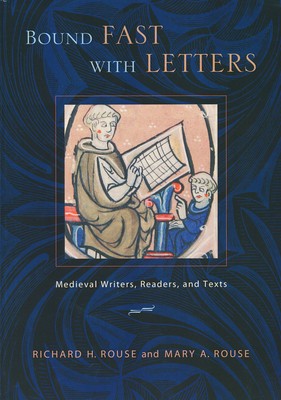
- We will send in 10–14 business days.
- Author: Richard H Rouse
- Publisher: University of Notre Dame Press
- ISBN-10: 0268205868
- ISBN-13: 9780268205867
- Format: 17.8 x 25.4 x 3.2 cm, kieti viršeliai
- Language: English
- SAVE -10% with code: EXTRA
Reviews
Description
Bound Fast with Letters brings together in one volume many of the significant contributions that Richard H. Rouse and Mary A. Rouse have made over the past forty years to the study of medieval manuscripts through the prism of textual transmission and manuscript production. The eighteen essays collected here address medieval authors, craftsmen, book producers, and patrons of manuscripts from different epochs in the Middle Ages, extending from late antiquity to the early Renaissance, and ranging from North Africa to northern England. Their investigations reveal valuable information about the history of texts and their transmission, and their careful scrutiny of texts and of the physical manuscripts that convey them illuminate the societies that created, read, and preserved these objects.
The book begins in Part I with articles on writers from the patristic era through the twelfth century who experimented with, and mastered, various physical forms of presenting ideas in writing. Part II contains essays on patronage and patrons, including Richard de Fournival, Jean de Brienne, Watriquet de Couvin, Pope Clement V, the Counts of Saint-Pol, and Christine de Pizan. Part III, on manuscript producers, discusses the questions, for whom? and by whom? were manuscripts made. The four essays in this section each reflect on a different part of the process of book-making. Throughout, Bound Fast with Letters focuses on the close ties between the physical remains of literate culture--from the wax tablets of the patristic era to the vernacular literature of the wealthy laity of the late Middle Ages--and their social and economic context.
EXTRA 10 % discount with code: EXTRA
The promotion ends in 21d.21:31:01
The discount code is valid when purchasing from 10 €. Discounts do not stack.
- Author: Richard H Rouse
- Publisher: University of Notre Dame Press
- ISBN-10: 0268205868
- ISBN-13: 9780268205867
- Format: 17.8 x 25.4 x 3.2 cm, kieti viršeliai
- Language: English English
Bound Fast with Letters brings together in one volume many of the significant contributions that Richard H. Rouse and Mary A. Rouse have made over the past forty years to the study of medieval manuscripts through the prism of textual transmission and manuscript production. The eighteen essays collected here address medieval authors, craftsmen, book producers, and patrons of manuscripts from different epochs in the Middle Ages, extending from late antiquity to the early Renaissance, and ranging from North Africa to northern England. Their investigations reveal valuable information about the history of texts and their transmission, and their careful scrutiny of texts and of the physical manuscripts that convey them illuminate the societies that created, read, and preserved these objects.
The book begins in Part I with articles on writers from the patristic era through the twelfth century who experimented with, and mastered, various physical forms of presenting ideas in writing. Part II contains essays on patronage and patrons, including Richard de Fournival, Jean de Brienne, Watriquet de Couvin, Pope Clement V, the Counts of Saint-Pol, and Christine de Pizan. Part III, on manuscript producers, discusses the questions, for whom? and by whom? were manuscripts made. The four essays in this section each reflect on a different part of the process of book-making. Throughout, Bound Fast with Letters focuses on the close ties between the physical remains of literate culture--from the wax tablets of the patristic era to the vernacular literature of the wealthy laity of the late Middle Ages--and their social and economic context.


Reviews